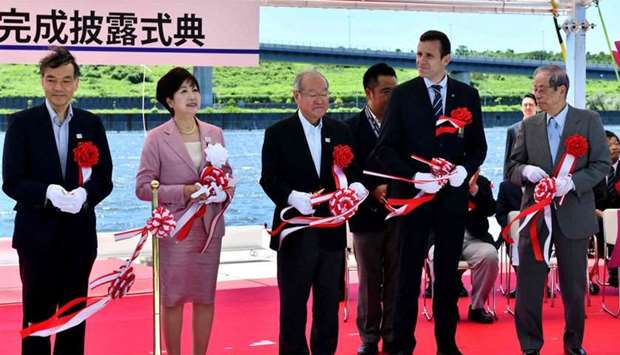The head of the International Rowing Federation has backed the newly opened 2020 Tokyo Olympic venue to provide a world-class test for athletes at next year's Summer Games.
The Sea Forest Waterway, which will also host sprint canoeing and be used for the Paralympics, opened on Sunday with a demonstration event completed in blustery conditions.
‘Of course the wind, if it's too strong, might be an issue,’ admitted world rowing chief Jean-Christophe Rolland, who won a gold medal for France at the 2000 Olympics.
‘But it's the fourth time I came here in Tokyo and this is the first time I've seen it so strong.
‘On an eight-day programme, I hope that we will find easily a time when the wind is not too strong and that we can have a good competition.’
Rolland praised Tokyo organisers for completing the venue on schedule.
‘Everything has been on track, on time and I am very pleased more than one year before the Olympic Games to be in such a position without any major issues,’ he told reporters.
‘There are still some little things to improve but we can be relieved we will have a good course for the Olympic Games.’
The Sea Forest Waterway is one of just eight permanent new venues being constructed for Tokyo 2020, in addition to 25 existing and 10 temporary venues out of a total of 43.
The 2,300-metre (2,500-yard) course was built on canals in Tokyo Bay next to an old landfill site that has been transformed into a forest for the Olympics.
- Early setbacks -
Its grandstand seats around 2,000 while an additional 16,000 spectators will be able to follow the action from temporary seating and standing areas, officials said.
Despite rowers and canoeists taking a buffeting in the winds, Rolland declared himself happy.
‘We have to cope with the local situation,’ he added. ‘Our intention is not to make a venue perfect (but) to make a venue fair for the athletes, the best at an acceptable cost.’
The new archery venue was completed in April as Tokyo organisers continue to deliver after a series of early setbacks.
They opened their first permanent venue -- the Musashino Forest Sport Plaza, which will host badminton and modern pentathlon fencing -- in 2017, which followed a disastrous rollout of plans for the Olympic stadium.
Japanese Prime Minister Shinzo Abe tore up the blueprints for the new national stadium in 2015 faced with public anger over its $2 billion price tag.
Designs for the official Games logo were subsequently scrapped following accusations of plagiarism, before Olympic organisers admitted that prolonged summer rain had brought high levels of bacteria to a venue earmarked for triathlon and open water swimming.
Tokyo officials have since been looking for ways to reduce their 1.35 trillion yen ($12 billion) budget, despite concerns from some sports bodies warning that cost-cutting could adversely affect the running of the Games.

